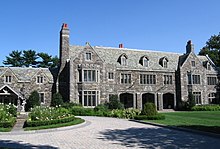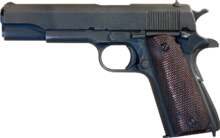Remington Rand
 Rock Ledge estate in Rowayton, Connecticut, company headquarters from 1943 to 1964 | |
| Company type | Public |
|---|---|
| Industry | Technology |
| Predecessors | |
| Founded | 1927 |
| Defunct | 1955 |
| Fate | Merged with Sperry Corporation in 1955 to become Sperry Rand; latter merged with Burroughs Corporation in 1986 to become Unisys |
| Headquarters | |
| Products |
|
| Divisions | |
Remington Rand, Inc. was an early American business machine manufacturer, originally a typewriter manufacturer and in a later incarnation the manufacturer of the UNIVAC line of mainframe computers. Formed in 1927 following a merger, Remington Rand was a diversified conglomerate making other office equipment, electric shavers, etc. The Remington Rand Building at 315 Park Avenue South in New York City is a 20-floor skyscraper completed in 1911.[1] After 1955, Remington Rand had a long series of mergers and acquisitions that eventually resulted in the formation of Unisys.
During World War II, Remington Rand produced M1911 pistols used by the United States Armed Forces.
History
[edit]Remington Rand was formed in 1927 by the merger of the Remington Typewriter Company and Rand Kardex Corporation. One of its earliest factories, the former Herschell–Spillman Motor Company Complex, was listed on the National Register of Historic Places in 2013.[2][3] Within the first year, Remington Rand acquired the Dalton Adding Machine Company, the Powers Accounting Machine Company, the Baker-Vawter Company, and the Kalamazoo Loose Leaf Binder Company.[4][5] From 1936 to 1937 Remington Rand workers went on strike, which resulted in violence and the loss of jobs.[6]
From 1942 to 1945, Remington Rand was a contract manufacturer of the M1911A1 .45 caliber semi-automatic pistol used by the United States Armed Forces during World War II. Remington Rand produced more M1911A1 pistols than any other wartime manufacturer.[7] Remington Rand ranked 66th among United States corporations in the value of World War II military production contracts.[8]
In 1950, Remington Rand acquired the Eckert–Mauchly Computer Corporation, founded by the makers of the ENIAC, and in 1952, they acquired Engineering Research Associates (ERA), both of which were pioneers in electronic computing. At that time, Remington Rand was one of the biggest computer companies in the United States.[9]
On June 14, 1951, the company's first computer was introduced, the UNIVAC I (Universal Automatic Computer). Many branches of the U.S. military, including the Air Force and the Army, were among the first to use the computers. When companies started to buy the computers, they would leave the computers at the Remington Rand facility since they were so big and bulky. The UNIVAC I was about the size of a one-car garage, and 46 of them were built and sold for $1 million each.[10]
Remington Rand was acquired by Sperry Corporation in 1955 to form Sperry Rand (later shortened to Sperry). However, the brand "Remington Rand" continued as a subdivision for many years.[11] Sperry merged in 1986 with Burroughs to form Unisys.[9]
Remington Rand was a regular co-sponsor of the CBS panel show What's My Line? throughout much of the show's run.[12][13]
Strike of 1936–1937
[edit]Remington Rand had a major worker strike between 1936 and 1937 when the company bought the Noiseless Typewriter Company in 1924, and the Noiseless Typewriter Company kept their company name and their workers were getting paid by Remington Rand. Also in the summer of 1936, James Rand Jr. tried to break up the strike by firing union workers and hiring new workers to take their places. Rand Jr. also threatened to close the plant. The strike got so severe that state and local police helped keep the strikers from throwing stones at workers and vehicles.[14]
The strike was started by the Federal Union, which was affiliated with the American Federation of Labor (AFL). James Rand Jr. used the idea of the Mohawk Valley Formula to try to break up the strike. The Mohawk Valley Formula was used to spread propaganda about the union strikes. The propaganda was carried out by spreading rumors and lambasting the union strikers for hurting their families, by having no income for their households since they were out of work. The propaganda was also often used to call the union strikers communist or anarchist, to make the public hate the union strikers.[15]
In 1937, the NLRB decided in favor of the workers, and the board ordered Rand to stop interfering with employees' unions and their right to organize. After the strike ended in the summer 1940, the Middletown plant had closed permanently, leaving 1,200 employees without jobs. There were still legal battles being fought for the employees that were in the strike while the plant was closing. The Middletown plant was run by strikebreakers until the closing of the plant in 1940.[15] Today the building is the home of Stubborn Beauty Brewery.[16]
Products
[edit]Typewriters
[edit]Initially produced by E. Remington and Sons, Remington typewriters were the first to use the QWERTY keyboard layout. Remington had bought the design from its inventor, Christopher Sholes. The Remington No.1 was the first model released. All keys were uppercase. Remington spun off Remington Typewriter Company in 1886, and after the 1927 merger, the Remington Rand Corp. continued to manufacture and sell typewriters.[17]
Colt M1911
[edit]
During World War II, Remington Rand produced 958,764 licensed copies of the M1911 pistol for the war effort between 1943 and 1945. These were shipped to the Springfield Armory as each contract was fulfilled. Colt Manufacturing Company was unable to fulfill the demand and was assisted by Remington Rand, Singer Corporation, Union Switch & Signal, Remington Arms and the Ithaca Gun Company. After the war all contracts for the 1911A1 were cancelled.
UNIVAC
[edit]The UNIVAC I (UNIVersal Automatic Computer I) was the second commercial computer made in the United States.[18] It was designed principally by J. Presper Eckert and John Mauchly, the inventors of the ENIAC. Design work was begun by their company, Eckert–Mauchly Computer Corporation, and was completed after the company had been acquired by Remington Rand. (In the years before successor models of the UNIVAC I appeared, the machine was simply known as "the UNIVAC".)[17]
The first UNIVAC was delivered to the United States Census Bureau on March 31, 1951, and was dedicated on June 14 that year.[19] The fifth machine (built for the U.S. Atomic Energy Commission) was used by CBS to predict the result of the 1952 U.S. presidential election. With a sample of 1% of the voting population it predicted Eisenhower's win.[17]
In 1949, Remington Rand designed the Remington Rand 409, a control panel programmed punched card calculator (but not introduced as a product until 1952 as the UNIVAC 60 then in 1953 as the UNIVAC 120 with double the memory).[17]
They also sold punched card systems, beginning with the 1928 acquisition of the Powers Accounting Machine Company and ending in the 1950s.
Electric razors
[edit]Remington Rand also made electric razors. The Remington brand of razor was originally produced by a division of Remington Rand, starting in 1937. Sperry Corporation sold the division in 1979 to Victor Kiam, who became the company spokesman of the new Remington Products Company. His line, "I liked the shaver so much, I bought the company" became one of the more memorable advertising slogans of the early 1980s.
Remington Products was sold in 2003 to the battery manufacturer Rayovac. Rayovac is now Spectrum Brands.
References
[edit]- ^ "Remington Rand Building, New York Cit". Skyscraperpage.com. Retrieved December 17, 2014.
- ^ "Cultural Resource Information System (CRIS)" (Searchable database). New York State Office of Parks, Recreation and Historic Preservation. Retrieved November 1, 2015. Note: This includes Kerry Traynor and Daniel McEneny (January 2013). "National Register of Historic Places Registration Form: Herschell–Spillman Motor Company Complex" (PDF). Retrieved November 1, 2015. and Accompanying photographs
- ^ "National Register of Historic Places Listings". Weekly List of Actions Taken on Properties: 6/17/13 through 6/21/13. National Park Service. June 28, 2013.
- ^ A History of Sperry Rand Corporation. Sperry Rand. 1967. p. 32.
- ^ "Remington Rand". Smithsonian Institution. Retrieved December 13, 2018.
- ^ Marlene Clark (July 4, 2007). "What Was The Noiseless Typewriter Strike Of 1936-1937?". courant.com. Retrieved December 13, 2018.
- ^ "1911/1911A1 Production Numbers". Archived from the original on February 12, 2009.
- ^ Peck, Merton J. & Scherer, Frederic M. The Weapons Acquisition Process: An Economic Analysis (1962) Harvard Business School p.619
- ^ a b Norberg, Arthur L. (June 1, 2005). Computers and Commerce: A Study of Technology and Management at Eckert–Mauchly Computer Company, Engineering Research Associates, and Remington Rand, 1946-1957. The MIT Press. ISBN 978-0-262-14090-4.
- ^ "50th anniversary of the UNIVAC I". cnn.com. June 14, 2001. Retrieved December 13, 2018.
- ^ Saunders, Cece. "Remington Rand Facility" (PDF). Midtown Planning. Retrieved December 17, 2014.
- ^ "Notable New Yorkers: Bennett Cerf". Columbia University Libraries Oral History Research Office. Columbia University. Retrieved March 3, 2020.
- ^ "What's My Line - Banned Episode, Smoking - 1950's". YouTube. November 21, 2011. Retrieved August 5, 2024.
- ^ Clark, Marlene (July 4, 2007). "What was the Noiseless Typewriter Strike of 1936-1937?". Hartford Courant. Retrieved December 13, 2018.
- ^ a b Smith, Anson C. (Spring 2015). "The 1936 Remington Rand Strike in Middletown: A Case Study in Propaganda". Connecticut History Review. 54 (1): 112–142. doi:10.2307/44370382. JSTOR 44370382. S2CID 254491530.
- ^ "contact". US: Stubborn Beauty Brewing Company. Retrieved March 9, 2022.
- ^ a b c d Norberg, Arthur Lawrence (2005). Computers and Commerce: A Study of Technology and Management at Eckert–Mauchly Computer Company, Engineering Research Associates, and Remington Rand, 1946-1957. MIT Press. ISBN 026214090X.
- ^ The first commercial computer in the world was the BINAC built by the Eckert–Mauchly Computer Corporation and delivered to Northrop Aircraft Company in 1949.
- ^ "CNN.com - Breaking News, U.S., World, Weather, Entertainment & Video News". Cnn.com. Retrieved December 17, 2014.
Further reading
[edit]- James W. Cortada, Before the Computer: IBM, NCR, Burroughs, and Remington Rand and the Industry They Created, 1865–1956 (Studies in Business and Technology), ISBN 0-691-05045-7
- Arthur L. Norberg, Computers and Commerce: A Study of Technology and Management at Eckert–Mauchly Computer Company, Engineering Research Associates, and Remington Rand, 1946–1957 (History of Computing) (Hardcover), ISBN 0-262-14090-X
- James M. Utterback, Mastering the Dynamics of Innovation, ISBN 0-87584-740-4
External links
[edit]- Rowayton Historical Society Web page on Remington Rand operations in Norwalk, Connecticut Archived March 23, 2008, at the Wayback Machine
- Rowayton Historical Society - The first business computer Archived November 4, 2016, at the Wayback Machine
- 1927 establishments in New York (state)
- 1955 disestablishments in New York (state)
- American companies established in 1927
- American companies disestablished in 1955
- Computer companies established in 1927
- Computer companies disestablished in 1955
- Defunct computer companies of the United States
- Defunct computer companies based in New York (state)
- Defunct computer hardware companies
- Defunct computer systems companies
- Defunct firearms manufacturers of the United States
- Defunct manufacturing companies based in New York City
- Defunct technology companies based in New York City
- Electronics companies established in 1927
- Manufacturing companies disestablished in 1955
- Manufacturing companies established in 1927
- Unisys


